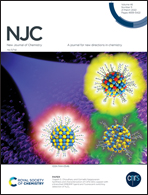The design and synthesis of metallophthalocyanine–gold nanoparticle hybrids as biological agents
Abstract
This study presents the synthesis of 4-2-(4-ethynyl-N,N-dimethylaniline)phthalonitrile (1) and its new peripherally tetra-substituted metal phthalocyanines {M = Co (2), Zn (3)}. Characterization of the prepared compounds was carried out by performing a series of spectroscopic techniques, such as NMR, UV-Vis, and mass spectroscopy. Additionally, all the compounds were utilized for modification of gold-nanoparticles (NG-1–3). The biological properties of the newly synthesized tetra-substituted metallophthalocyanine–gold nanoconjugates were studied for the first time in this study. The obtained results were compared with the biological features of the bulk compounds (1–3), as well. The DPPH scavenging activity of all the structures (1–3, NG-1–3, and NG) was investigated. They exhibited high antioxidant activities. Also, compounds 1–3 and NG-1–3 displayed DNA cleavage activities. The antimicrobial activity of the compounds (1–3, NG-1–3, and NG) was studied using microdilution and disc diffusion assays. Their microbial cell viability inhibition activities were examined against E. coli and all the tested compounds inhibited E. coli growth 100% at 500 mg L−1. Additionally, they demonstrated significant biofilm inhibition against S. aureus and P. aeruginosa.



 Please wait while we load your content...
Please wait while we load your content...